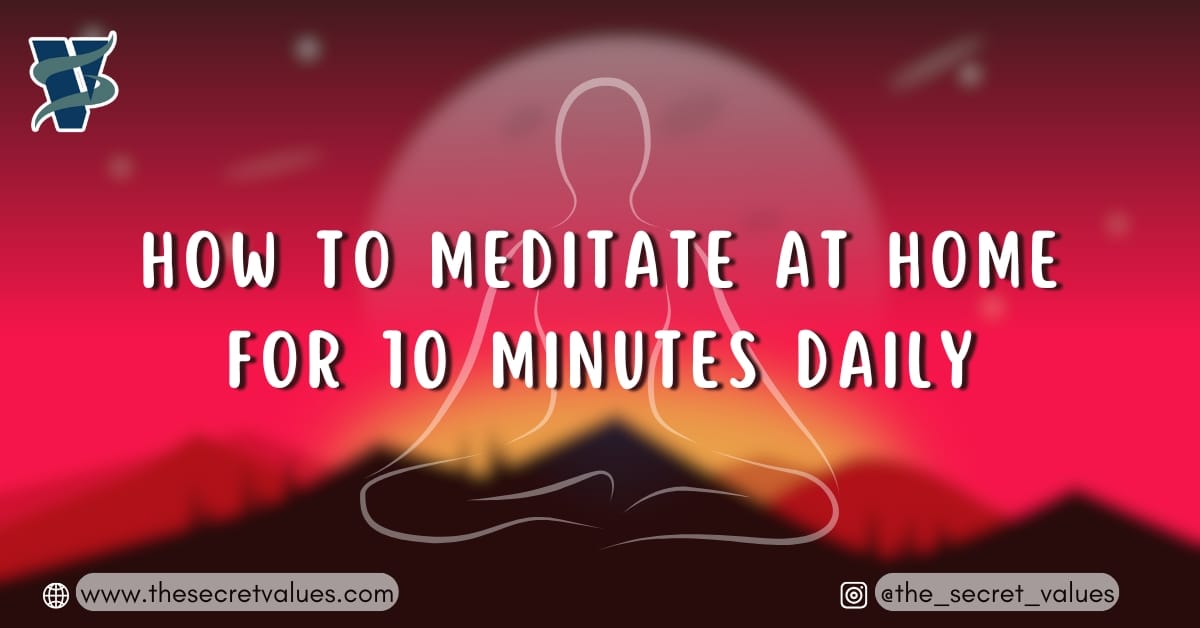Meditation is one of the simplest and most effective ways to improve mental and physical well-being. But how do you meditate at home for just 10 minutes a day? With guidance and consistency, You may improve your routine while reaping the advantages of mindfulness. This article will explore how to meditate at home, focusing on beginner-friendly techniques and practical tips.
Introduction to Meditation
What is Meditation?
Meditation is a discipline that helps you focus your mind and achieve a state of calm and clarity. It’s not about forcing your thoughts away but learning to observe them without judgment. Think of it as a mental workout that trains your brain to be more present.
Why Meditation Matters
Life may be daunting. With a job, family, and an endless to-do list, finding a moment to breathe seems impossible. This is when meditation comes in. It’s like hitting the reset button on your mind, helping you stay centered and stress-free.
Benefits of Meditating at Home
Mental Health Benefits
Meditation is not limited to monks in monasteries. Regular practice:
- Reduce stress and anxiety.
- Improve focus and concentration.
- Enhance emotional resilience.
Physical Health Benefits
Did you know meditation can also improve your body’s health? It can:
- Lower blood pressure.
- Improve sleep quality.
- Boost your immune system.
Preparing for Your Meditation Practice
Choosing the Right Space
The first step in learning how to do meditation at home is finding a dedicated space. A calm space in your living room or bedroom will suffice; nothing spectacular is required. The goal is to choose a location where you feel peaceful and interruptions-free.
Setting Up Your Environment
Want to make your meditation space inviting? Add:
- A comfortable cushion or chair.
- Soft lighting.
- Calming scents like lavender or sandalwood.
How to Meditate at Home for 10 Minutes Daily
Basic Meditation Techniques
Start simple. Sit comfortably, shut your eyes, and concentrate on your breathing. Count each inhale and exhale. When your mind wanders—and it will—gently bring it back to your breathing.
Creating a Routine
Consistency is key. Set aside the same 10 minutes each day. Whether it’s morning, noon, or night, pick a time that works best for you and stick to it.
How to Do Meditation for Beginners at Home
Breathing Exercises
Breathing is the foundation of meditation. Try this:
- Inhale deeply for four counts.
- Hold your breath for four counts.
- Exhale slowly for six counts. This easy practice might help you relax and concentrate.
Guided Meditation Options
Are you not sure where to start? Apps like Headspace or Calm offer beginner-friendly guided sessions. They’re like having a personal coach right in your pocket.
Overcoming Common Challenges
Staying Consistent
Let’s be honest: Forming new behaviors is difficult. Set reminders on your phone, or combine meditation with an established habit, such as brushing your teeth.
Dealing with Distractions
Kids, pets, and noisy neighbors can make meditating at home tricky. Use noise-canceling headphones or play soft background music to drown out distractions.
Advanced Tips for Meditation Enthusiasts
Incorporating Mindfulness into Daily Life
Meditation doesn’t have to stop when your timer goes off. Focusing on the present moment might help you practice mindfulness throughout the day, whether eating, walking, or working.
Using Meditation Apps and Tools
Enhance your practice with apps, timers, or a simple journal to track your progress and reflect on your experiences.
Conclusion
Meditating for 10 minutes at home daily can do great things for your body and mind. You will soon see the benefits of dedicating a location, using simple tactics, and remaining consistent. Why wait? Begin today and discover how meditation may improve your life.
FAQs
How can I avoid distractions while meditating at home?
Choose a quiet space, use headphones, and tell family members not to disturb you during meditation.
Is it necessary to meditate at the same time every day?
While it’s not mandatory, meditating simultaneously helps build a habit and ensures consistency.
Can meditation help with anxiety?
Absolutely! Regular meditation can reduce anxiety by promoting relaxation and improving emotional control.
What is the best time to meditate at home?
The best time is whenever you’re least likely to be interrupted. Morning is often ideal because it sets a calm tone for the day.
Do I need special equipment to meditate?
No, you don’t need anything fancy. A comfortable seat and a quiet space are all you need to get started.








2 thoughts on “How to Meditate at Home for 10 Minutes Daily”